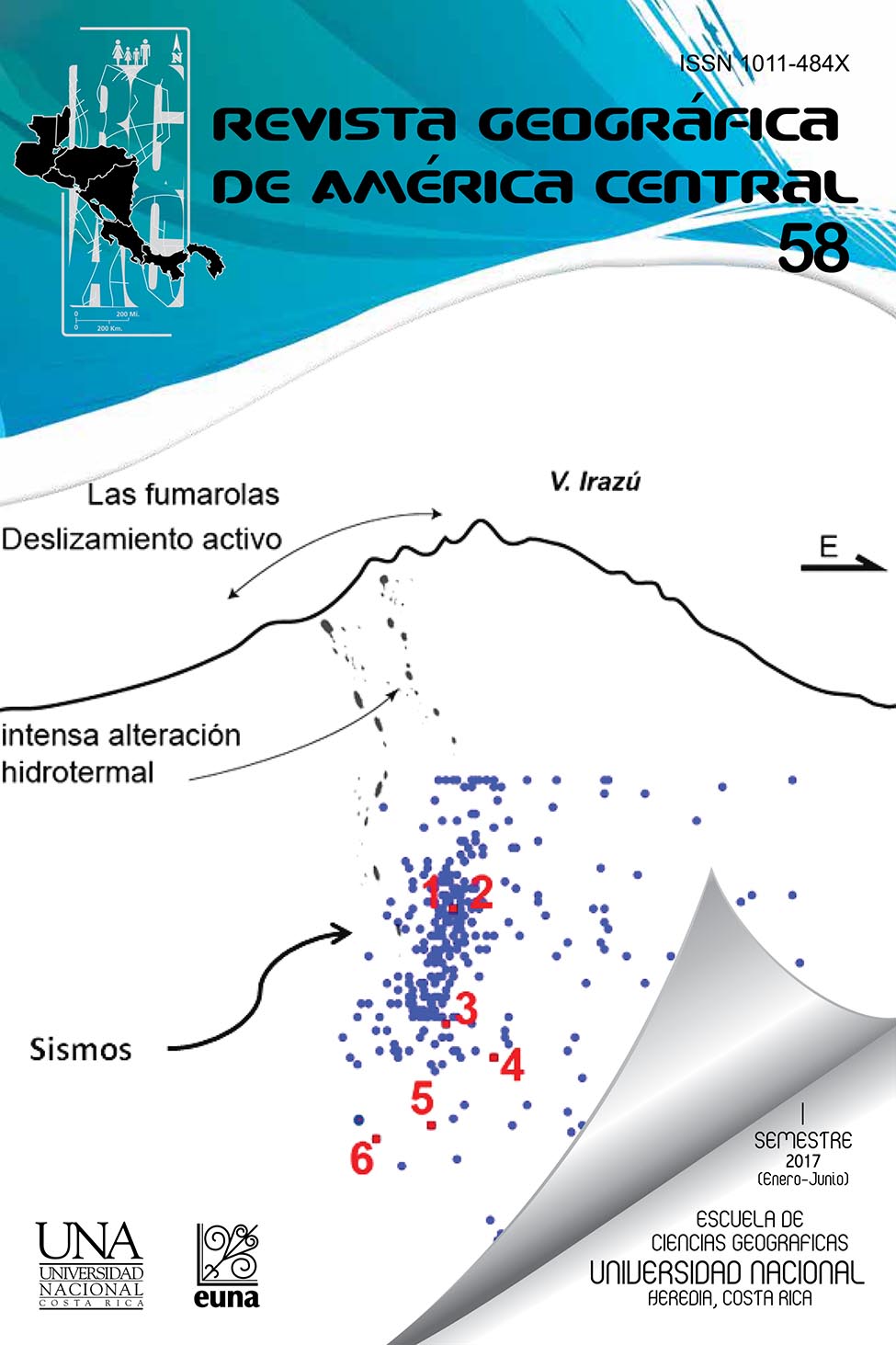INTERPRETACIÓN DE LOS SISMOS PEQUEÑOS Y MODERADOS BAJO EL VOLCÁN IRAZÚ
DOI:
https://doi.org/10.15359/rgac.58-1.7Palabras clave:
volcán Irazú, sismicidad, mecanismos focales, fallas normalesResumen
El volcán Irazú históricamente ha presentado sismicidad volcano-tectónica esporádica. A partir de esta actividad sísmica hemos calculado un total de 7 mecanismos focales utilizando la polaridad de primeros arribos. Además, hemos realizado la inversión de esfuerzos utilizando el método PTB. Los resultados indican que la actividad sísmica se produce a profundidades entre 0-6 km en el flanco Oeste del macizo volcánico. Los mecanismos focales muestran una cinemática variada, los ángulos de los planos tienen una media de 55º y la dirección de inclinación es hacia el Sur Oeste Oeste. La inversión de esfuerzos sugiere una extensión pura con un valor de R’ = 0,5. La profundidad donde ocurren los eventos sísmicos y el ángulo medio de los planos nos hace suponer que el límite dúctil-frágil se encuentra por encima de lo teóricamente establecido. Nosotros planteamos que la fuente sísmica bajo el volcán Irazú está directamente relacionada con la presencia de magma cerca de la superficie, el cual produce adelgazamiento de la corteza y fallamiento normal asociado.Referencias
Allmendinger, R., Reilinger, R. y Loveless, J. (2007). Strain and Rotation Rate from GPS in Tibet, Anatolia, and the Altiplano. Tectonics, 26(TC3013), 1-18. doi:10.1029/2006TC002030.
Alvarado, G. E. (1993). Volcanology and Petrology of Irazú Volcano, Costa Rica. Kiel: Univ. Kiel.
Alvarado, G. E. (2011). Los volcanes de Costa Rica: Geología, historia, riqueza natural y su gente. San José: EUNED.
Alvarado, G. E., y Schmincke, H. U. (2013). The 1723 A.D. Violent Strombolian and Phreatomagmatic Eruption at Irazú Volcano, Costa Rica. Revista Geológica de América Central, 48, 41-61.
Alvarado, G. E., Carr, M., Turrin, B., Swisher, C., Schmincke, H., y Hudnut, K. (2006). Recent volcanic history of Irazú volcano, Costa Rica: Alternation and mixing of two magma batches, implying at least two intracrustal chambers. En Rose, W., Bluth, G., Carr, M., Ewert, J., Patino, L., y Vallance, J. Natural Hazards in Central America, 412, pp. 259-276. Geological Society of America Special Paper. doi:10.1130/2006.2412(14).
Anderson, E. M. (1951). The Dynamics of Faulting, Etc. (Revised.). Edinburgh, London.
Angelier, J. (2002). Inversion of earthquake focal mechanisms to obtain the seismotectonic stress IV - a new method free of choice among the nodal planes. Geophysical Journal International, 150, 588-609.
Angelier, J., Bergerat, F., Dauteuil, O. y Villemin, T. (1997). Effective tension-shear relationships in extensional fissure swarms, axial rift zone of northeastern Iceland. Journal of Structural Geology, 19, 673-685. doi:10.1016/S0191-8141(96)00106-X.
Barquero, R., Mora, M., Madrigal, L., Vargas, I., Arias, F. y Soto, G. (1995). Resumen anual de sismos y actividad volcánica en Costa Rica durante 1994. OVSICORI [Informe Interno].
Bott, M. P. (1959). The mechanics of oblique slip faulting. Geological Magazine, 96, 109-117.
Buck, R. W., Einarsson, P. y Brandsdóttir, B. (2006). Tectonic stress and magma chamber size as controls on dike propagation: Constraints from the 1975–1984 Krafla rifting episode. Journal of Geophysical Research, 111(B12404), 1-15. doi:10.1029/2005JB003879.
Carey, E. y Brunier, B. (1974). Analyse théorique d'un modèle mécanique élémentaire aplié à l'étude d'une population de failles. Comptes Rendus de l'Académie des Sciences Paris, 279, 891-894.
Clark, S., Reagan, M., y Trimble, D. (2006). Tephra deposits for the past 2600 years from Irazú volcano, Costa Rica. En Rose, W., Bluth, G., Carr, M., Ewert, J., Patino, L., y Vallance, J. Natural Hazards in Central America, 412, pp. 225-234 Geological Society of America Special Paper. doi:10.1130/2006.2412(12).
Collettini, C. y Sibson, R. H. (2001). Normal faults, normal friction? Geology, 29, 927-930. doi:10.1130/0091-7613(2001)0292.0.CO;2.
Dauteuil, O., Angelier, J., Bergerat, F., Verrier, S. y Villemin, T. (2001). Deformation partitioning inside a fissure swarm of the northern Iceland rift. Journal of Structural Geology, 23, 1359-1372. doi:10.1016/S0191-8141(01)00002-5.
Day, W. C., Dickerson, R. P., Potter, C. J., Sweetkind, D. S., San Juan, C. A., Drake, R. M. y Fridrich, C. J. (1998). Bedrock geologic map of the Yucca Mountain area, Nye County, Nevada. [Mapa]. Escala 1:24000. U.S. Geological Survey Miscellaneo Investigations Series Map. Nevada, EE.UU. I-2627.
Delvaux, D., Moeys, R., Stapel, G., Petit, C., Levi, K., Miroshnichenko, A., Ruzhich, V. y San'kov, V. (1997). Paleostress reconstructions and geodynamics of the Baikal region, central Asia, Part 2. Cenozoic rifting. Tectonophysics, 282(1), 1-38.
Fernández, E., Barquero, J., Barboza, V., Van Der Laat, R., Malavassi, E., Sáenz, R., Marino, T. y Martínez, M. (1994). Estado de los volcanes. Boletín de Vulcanología. OVSICORI-UNA [Informe Interno].
Ferrill, D. A. y Morris, A. P. (2003). Dilational normal faults. Journal of Structural Geology, 25, 183-196. doi:10.1016/S0191-8141(02)00029-9.
Ferrill, D. A., Sims, D. W., Waiting, D. J., Morris, A. P., Franklin, N. y Schultz, A. L. (2004). Structural framework of the Edwards Aquifer recharge zone in south-central Texas. Geological Society of America Bulletin, 116, 407-418. doi:10.1130/B25174.1.
Gephart, J. W. y Forsyth, D. W. (1984). An improved method for determining the regional stress tensor using earthquake focal mechanism data: Application to the San Fernando earthquake sequence. Journal of Geophysical Research, 89, 9305-9320.
Hayward, N. y Ebinger, C. (1996). Variations in the along-axis segmentation of the Afar rift system. Tectonics, 15, 244-257.
Jackson, J. A. y White, N. J. (1989). Normal faulting in the upper continental crust: Observations from regions of active extension. Journal of Structural Geology, 11, 15-36. doi:10.1016/0191-8141(89)90033-3.
Krushensky, R. D. (1972). Geology of Istarú Quadrangle. Washington D.C.: U.S. Geological Survey Bulletin, 1358.
Kusznir, N. J., y Park, R. G. (1984). Intraplate lithosphere deformation and the strength of the lithosphere. Geophysical Journal International, 79(2), 513-538.
Opheim, J. A. y Gudmundsson, A. (1989). Formation and geometry of fractures, and related volcanism, of the Krafla fissure swarm, northeast Iceland. Geological Society of America Bulletin, 101, 1608-1622. doi:10.1130/0016-7606(1989)1012.3.CO;2.
Pacheco, J. P., Muller, C., Avard, G., Cascante, M. y Martínez, M. (2015). Estado de los volcanes. Boletín de Vulcanología. OVSICORI [Informe Interno].
Reston, T. J. y Pérez-Gussinyé, M. (2007). Lithospheric extension from rifting to continental breakup at magma-poor margins: rheology, serpentinisation and symmetry. International Journal of Earth Sciences, 96, 1033-1046.
Rowland, J., Baker, E., Ebinger, C., Keir, D., Kidane, T., Biggs, J., Hayward, D. y Wright, T. (2007). Fault growth at a nascent slow-spreading ridge: 2005 Dabbahu rifting episode, Afar. Geophysical Journal International, 171, 1226-1246.
Ryan, W. F., Carbotte, S. M., Coplan, J. O., O'Hara, S., Melkonian, A., Arko, R., Weissel, R.A., Ferrini, V., Goodwillie, A., Nitsche, F., Bonczkowski, J. y Zemsky, R. (2009). Global Multi-Resolution Topography synthesis. Geochemistry Geophysics Geosystems, 10(Q03014), 1-9. doi:10.1029/2008GC002332.
Shelly, D. R. y Hill, D. P. (2011). Migrating swarms of brittle-failure earthquakes in the lower crust beneath Mammoth Mountain, California. Geophysical Research Letters, 38(L20307), 1-6. doi:10.1029/2011GL049336.
Ulloa, A., Campos-Fernández, C. S. y Rojas, L. (2013). Cueva los minerales, volcán Irazú, Costa Rica: descripción, mineralogía y origen. Revista Geológica de América Central, 48, 169-187.
Walsh, J. J. y Watterson, J. (1988). Dips of normal faults in British Coal Measures and other sedimentary sequences. Journal of the Geological Society, London, 145, 859-873.
Wright, T., Ebinger, C., Biggs, J., Ayele, A., Yirgu, G., Keir, D. y Stork, A. (2006). Magma-maintained rift segmentation at continental rupture in the 2005 Afar dyking episode. Nature, 422, 291-294.
Yamada, Y. y McClay, K. (2003). Application of geometric models to inverted listric fault systems in sandbox experiments. Paper 1: 2D hanging wall deformation and section restoration. Journal of Structural Geology, 25(9), 1551-1560. doi:10.1016/S0191-8141(02)00181-5.
Zoback, M. L. (1992). First- and second-order patterns of stress in the lithosphere: The World Stress Map Project. Journal of Geophysical Research, 97(B8), 11703-11728. doi:10.1029/92JB00132.
Descargas
Publicado
Cómo citar
Número
Sección
Licencia
Política propuesta para Revistas que ofrecen Acceso Abierto
Los autores que publican en esta revista están de acuerdo con los siguientes términos:
a. Los autores conservan los derechos de autor y garantizan a la revista el derecho de ser la primera publicación del trabajo, bajo la Licencia https://creativecommons.org/licenses/by-nc-sa/4.0/deed.es, que permite a otros compartir con un reconocimiento de la autoría del trabajo y la publicación inicial en esta revista.
b. Los autores pueden establecer por separado acuerdos adicionales para la distribución no exclusiva de la versión de la obra publicada en la revista (por ejemplo, situarlo en un repositorio institucional o publicarlo en un libro), con un reconocimiento de su publicación inicial en esta revista. Esos acuerdos adicionales deben respetar los términos de la licencia: es decir: no involucrar fines de lucro y compartir con la misma licencia.
c. Se anima a los autores a archivar el post-print o versión de editor/PDF en repositorios de acceso abierto.







 REVGEO se encuentra bajo la licencia https://creativecommons.org/licenses/by-nc-sa/4.0/deed.es
REVGEO se encuentra bajo la licencia https://creativecommons.org/licenses/by-nc-sa/4.0/deed.es
.svg_4.png)

_(1).png)
_(1)_(1)_(1)_1.png)
(2)(1)(1)(1).png)
